 Home
Home
rOm
Quest
Glossary
Random
Page
Search
Site
Lush
Sim
Class
Subject
Images
Help
FAQ
Sign
Up
Log
In
WANTED: Individual or team to take over this project. I'm in my 70's and want to put my feet up. Contact details in footer.
Capacitors store energy in the form of charge.
They are like electronic buckets filled with electrons or perhaps more like compressed gas cylinders.
The potential difference across a capacitor changes slowly unless large currents are flowing.
Nick Reeder's Capacitor Challenge
-
Capacitors store energy in the form of charge.
-
Charge is either more or fewer electrons than normal in uncharged material.
-
Volts ( V ) push the charge around creating the excess or lack.
-
Capacitance ( C ) is measured in Farads.
-
Charge ( Q ) is measured in Coulombs.
-
The charge Q = C V.
-
Capacitance is defined as the number of coulombs stored per volt across the capacitor. C = Q / V
-
The energy stored is measured in Joules.
-
The energy stored = 0.5 C V2
-
If the voltage is big, the stored energy can be enormous and lethal.
Capacitor Construction
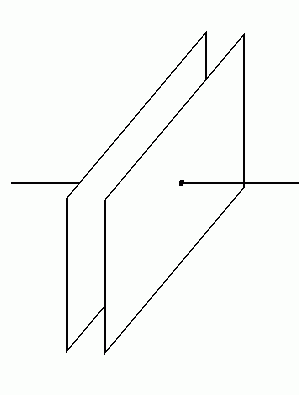
Two parallel metal or foil plates insulated from each other. Many capacitors have this structure rolled up into a tube to save space.
Capacitor Symbols and Images
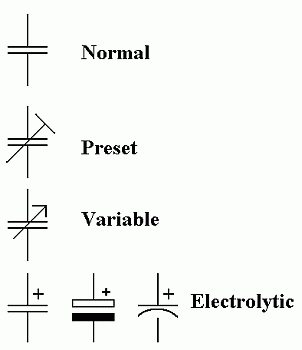 |
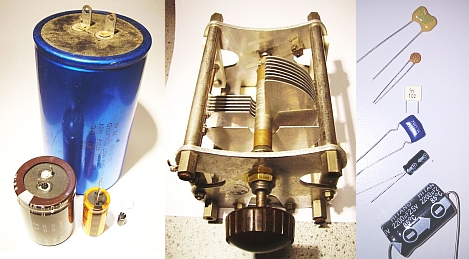
Left to right ...
-
Electrolytic - Connect the right way round to prevent explosion!
-
Tuning - A variable capacitor used for tuning a radio transmitter.
-
Small capacitors including two electrolytics. Look for the arrows with the minus signs.
|
Capacitor Simulations
Click the switch to alternate between charging and discharging.
This animation has correct physics so it could be used to plot a realistic capacitor charging graph.
|
|
On the animation page, click the Fill/Empty button to alternate between filling and emptying.
-
It takes time to fill the tank / charge the capacitor
-
The tank/capacitor fills fast at first and the fill rate slows down, the fuller it gets
-
The tank/capacitor empties fast at first and the emptying rate slows down, the emptier it gets
-
Eventually the battery/reservoir would be drained
-
The water level/capacitor charge can not change suddenly
-
If there were more pressure/voltage, the tank/capacitor would fill faster
-
The tank fills until the water levels are equal. The capacitor charges until the voltages are equal.
|
Capacitor Properties
The main characteristics or properties of capacitors are ...
-
Capacitance is measured in Farads or more often pico, nano or microfarads.
-
One Farad is an enormous capacitance and rarely found in real life.
-
Capacitors store energy in the form of a stored electric charge.
-
Charge is measured in Coulombs.
-
Energy is measured in Joules.
-
Q = CV where
-
Q is the charge,
-
C is the capacitance and
-
V is the potential difference across the capacitor
-
If you double the voltage, the stored charge will double.
-
E = CV2 / 2 where
-
E is the energy stored,
-
C is the capacitance and
-
V is the potential difference across the capacitor
-
If you double the voltage, the energy stored increases by 22 (four times)
More details ...
-
capacitors block direct current (DC)
-
capacitors pass alternating current (AC)
-
The breakdown voltage (in Volts). The voltage across the capacitor should never exceed this.
-
The upper useful frequency properties.
-
The DC leakage current (a particular problem with electrolytic capacitors).
YouTube Video: VERY Big Capacitor vs Watermelon
Electrolytic and Tantalum Capacitors
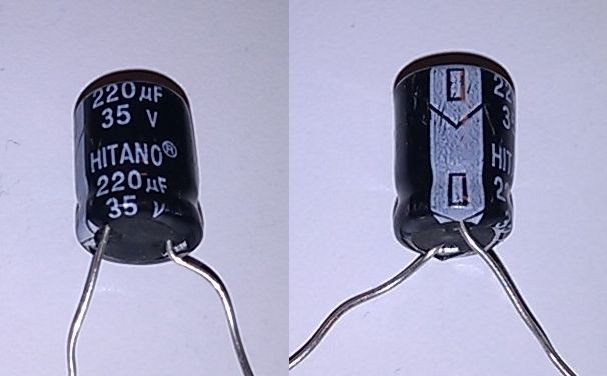
Electrolytic capacitors use thin rolled up foil plates separated by a liquid or gel electrolyte. The insulation between the plates relies on a chemical reaction. If the capacitor is connected up the wrong way round, this chemistry fails and the capacitor works as a conductor instead. It gets hot and can explode!
-
The negative pin is indicated by the arrows and minus signs.
-
Electrolytic capacitors have a very large capacitance for their size.
-
The working voltage is low. 12 to 160 volt ratings are common. The image above shows a 35 Volt capacitor.
-
They have a significant DC leakage current, sufficient to upset some timing circuits
-
They are not manufactured with good tolerance / accuracy and this can be up to 50% out
-
Their capacitance is not stable and can change with time
-
They are not suitable for high frequency radio applications because the coiled up foil roll acts as an inductor blocking high frequency performance
-
They work well at audio and ultrasonic frequencies.
Their uses include ...
-
DC power supply smoothing - This is a particular example of decoupling.
-
Audio signal coupling - Block DC and pass AC.
-
Audio signal decoupling - Remove unwanted AC signals.
-
Timing in 555 or other timer circuits - RC resistor capacitor circuit
They can not be used ...
-
In AC circuits where the polarity across the capacitor reverses
-
In logic gate astable circuits because the polarity across the capacitor reverses
Capacitor Labelling
|
Big Capacitors |
These have the value printed in plain language like 4700 µF and there is no problem. |
|
Tiny Capacitors |
Tiny capacitors might be labelled with a number up to three digits long. These are values in picofarads (puffs) and the third digit (if present) is the number of zeros you need to add. If there is a letter, this is the capacitor tolerance (accuracy of manufacture). J = 5%. K = 10%. M = 20%. Google for the other tolerance codes if you need them.
Examples:
-
8 = 8 picofarads
-
22 = 22 picofarads
-
121 = 120 picofarads (add one zero)
-
332 = 3300 picofarads (add two zeros)
-
473 = 47000 picofarads or 47 nanofarads (add three zeros)
|
|
Working Voltage |
On big capacitors, this is clearly labelled. On tiny capacitors it might not be labelled at all. Usually small capacitors will be safe in any sensible school project because they have a high enough voltage rating. Electrolytic capacitors are more of a problem. You must take care that the voltage rating is higher than any voltage the capacitor will experience at any time in your circuit. It is a good idea to allow a safety margin so use a 16 Volt capacitor in a 12 Volt circuit. High voltage capacitors tend to be physically large so, if possible, it is a good idea to design circuits to work on lower voltages. Alternatively design circuits that avoid the use of capacitors.
This is a 0.1 microfarad or 100 nanofarad capacitor rated up to a maximum of 63 Volts.
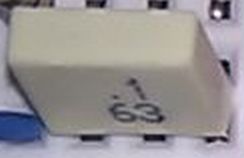
|
Subject Name
Level
Topic Name
Question Heading
First Name
Last Name Class ID
User ID
Question Text
image url
Help Link
Add
Delete
Clone
Edit
Hardness
Help Text
Debug
- You can attempt a question as many times as you like.
- If you are logged in, your first attempt, each day, is logged.
- To improve your scores, come back on future days, log in and re-do the questions that caused you problems.
- If you are logged in, your most recent wrong answers get remembered. This might help you and your teacher to correct your understanding.
- In the grade book, you can delete your answers for a topic before re-doing the questions. Avoid deleting unless you intend re-doing the questions very soon.




